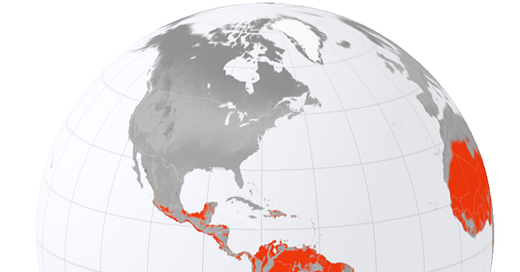Don't Play Footsie with Racism
Climate determinism is alive and well in climate research and reporting

A recent CNN story warned that, “If the current pace of global warming goes unchecked, it will push billions of people outside the “climate niche,” which is described as “the temperatures where humans can flourish.” CNN was reporting on a recent study that sought to identify those regions of the Earth that might change in ways that place large parts of the world outside that “niche,” and as a consequence, look to migrate somewhere else.
The “human climate niche” is a phrase developed by the same people who brought us “planetary boundaries” — a concept which has been invoked a justification for setting up new institutions of non-state governance to enforce those boundaries. Many of these scientists are now associated with or self-appointed members of an “Earth Commission” that seeks to establish and enforce targets and metrics for limiting the actions of governments and businesses. Science is invoked as the basis for these actions, in the form of various published papers.
Today, I take closer look at some of these papers which have promoted the notion of a “human climate niche.” This concept perpetuates climate determinism — a theory well over a century old that has been discredited as not just wrong, but imperialist and racist. It is uncomfortable territory, to be sure, but a topic that the climate community should engage with openly.
Let’s get into the details.
The “human climate niche” was promoted in a 2019 paper that explained:
All species have an environmental niche, and despite technological advances, humans are unlikely to be an exception. Here, we demonstrate that for millennia, human populations have resided in the same narrow part of the climatic envelope available on the globe, characterized by a major mode around ∼11 °C to 15 °C mean annual temperature (MAT).
The idea that humans thrive in a limited range of temperatures has a very long history. Mike Hulme explains that in the early 20th century climate determinists argued that:
… aspects of climate exerted a powerful shaping influence on the physiology and psychology of individuals and races, which in turn shaped decisively the culture, organization, and behavior of the society formed by those individuals and races. Tropical climates were said to cause laziness and promiscuity, while the frequent variability in the weather of the middle latitudes led to more vigorous and driven work ethics.
The theory of climate determinism is often associated with geographer Ellsworth Huntington (1876-1947).
Hulme continues, writing of Huntington,
Based on his belief that there were optimal—and universally optimal—climates for physical and mental activity, Huntington drew upon a number of empirical studies of factory workers in America to suggest that 20°C and a humidity of 60 percent maximized productivity. It was a short step from here to postulate that the energy and vigor needed to develop and sustain civilizations was also related to these climatic optima, giving rise to his “mainsprings of civilization” hypothesis. And for Huntington a further short step into the emerging field of genetic selection was to bring him in the 1920s under the influence of the American eugenics movement.
Right away, the connection between Huntington’s “universally optimal climate” and the “human climate niche” is obvious — they are essentially the same concept. The promoters of the “human climate niche” argue that “the historically stable and tight relationship of human distribution to [mean average temperature] represents a human temperature niche reflecting fundamental constraints on human populations.” In both conceptions, humanity thrives when temperatures are cooler, and suffers when temperatures are warmer.
Using the definition of the “human climate niche” proposed n 2019, we can classify the parts of the world that today sit within the “human climate niche” and those that sit outside that niche — that is, outside the “the climatic conditions needed for human thriving.”
The “major mode” of the “human climate niche” was defined in 2019 as those places where “mean average temperatures” lie between ~11C and 15C. Wikipedia lists 460 cities around the world according to their mean average temperatures. Of these cities, 68 fall within the “human climate niche,” and of these 68 cities, 47 are in North America, Europe, Australia and New Zealand. Examples include: London, New York City, Boston, Paris, Washington, DC, Canberra, Milan and Philadelphia. Also found inside the niche are Beijing, Seoul and Santiago. These places, the argument goes, are where humanity thrives.
Outside this niche are most of the world’s large cities -- including Shanghai, Hong Kong, Guangzhou, New Delhi, Kolkata, Mumbai, Jakarta, Tokyo, Mexico City, and hundreds more, including every city on the continent of Africa. These are places where apparently humanity does not “flourish” because they are outside the “human climate niche.”
The authors of the 2019 paper knew very well where there analysis sat in historical context, writing:
Rather than reentering the murky waters of environmental determinism, here we take a fresh look at this complex and contentious issue.
However, as judged by their results, rather than a “fresh look” they merely recreated the old trope that human thriving takes place in the cool temperatures of Northern Europe and North America, while most of the rest of the world sits outside that wonderful niche. Ironically, the lead author of that 2019 paper works in Nanjing, China — with a MAT of 16.1C — placing it outside their ”major mode” of the “human climate niche.”
Here is where things get really uncomfortable.
The authors warn — misusing the nonexistent RCP8.5 married to SSP3 — that we should be prepared for the many billions who live outside the niche to want to move into it, suggesting the possibility of mass migrations:
[F]or the RCP8.5 business-as-usual climate scenario, and accounting for expected demographic developments (the SSP3 scenario [15]), ∼3.5 billion people (roughly 30% of the projected global population; SI Appendix, Fig. S12) would have to move to other areas if the global population were to stay distributed relative to temperature the same way it has been for the past millennia . . .
The authors then explain that they are not actually raising fears about migration: “Obviously, our hypothetical redistribution calculations cannot be interpreted in terms of expected migration.” Such disclaimers — wink, wink — of course did not stop the media from running apocalyptic stories about the coming wave of immigrants, perhaps billions of them coming to our shores, with the full support of the paper’s authors.
An example can be found in The New York Times, which produced an elaborate multimedia story on the paper that warned ominously:
People are already beginning to flee. In Southeast Asia, where increasingly unpredictable monsoon rainfall and drought have made farming more difficult, the World Bank points to more than eight million people who have moved toward the Middle East, Europe and North America. In the African Sahel, millions of rural people have been streaming toward the coasts and the cities amid drought and widespread crop failures. Should the flight away from hot climates reach the scale that current research suggests is likely, it will amount to a vast remapping of the world’s populations.

The New York Times story was full of pictures of poor brown people (and only poor brown people, examples from the story are above) heading to the U.S. southern border. The imagery evoked not just the old academic idea of climate determinism, but as well, the common racist tropes used by U.S. politicians and media to scare citizens about immigration.
The New York Times asked ominously: “Where will they go?”
It provided an answer by quoting a recitation of Garrett Hardin’s lifeboat ethics: “If we don’t develop a different attitude, we’re going to be like people in the lifeboat, beating on those that are trying to climb in.”
This is not subtle. You may recall that Hardin is also well known for the “Tragedy of the Commons,” which has been influential in generations of environmental thinking and policy. The “Tragedy of the Commons” is also racist. Hardin’s “lifeboat ethics” essay followed similar themes and was titled: “Lifeboat Ethics: the Case Against Helping the Poor.”
Hardin explained in that essay:
If we divide the world crudely into rich nations and poor nations, two thirds of them are desperately poor, and only one third comparatively rich, with the United States the wealthiest of all. Metaphorically each rich nation can be seen as a lifeboat full of comparatively rich people. In the ocean outside each lifeboat swim the poor of the world, who would like to get in, or at least to share some of the wealth. What should the lifeboat passengers do?
Lifeboat ethics were about hard planetary limits that required that human actions and behaviors be regulated. As Hardin explained, “we must recognize the limited capacity of any lifeboat” and further, “Every human born constitutes a draft on all aspects of the environment: food, air, water, forests, beaches, wildlife, scenery and solitude.”
For Hardin, a main threat to rich countries was immigration from poor countries — which brings us back to the “human climate niche” and its supposed consequences. One of the authors of the “human climate niche” paper told the New York Times that their disclaimers about migration inserted into the paper weren’t really that sincere:
This spring, after Proceedings of the National Academy of Sciences published the explosive study estimating that, barring migration, one-third of the planet’s population may eventually live outside the traditional ecological niche for civilization, Marten Scheffer, one of the study’s authors, told me that he was asked to tone down some of his conclusions through the peer-review process and that he felt pushed to “understate” the implications in order to get the research published. The result: Migration is only superficially explored in the paper.
Wink, wink.
A few weeks ago, a new “human climate niche” paper was published by the original contributors along with new co-authors. It is perhaps telling that in the new version, the emphasis on the “human climate niche” has now expanded dramatically, from ~11C-15C to 13C-25C, which encompasses many more regions of the world. The emphasis is now much greater on exceedingly hot temperature thresholds, rather than the niche itself. This change in definition and emphasis may or may not represent a degree of self-awareness by the authors of the historical roots and connotations of the original formulation.
What is absolutely certain however is that the dramatic shift in the definition of the “human climate niche” in different papers in 2019 and 2023 shows the incredible plasticity of the concept, which can obviously be constructed in many different ways. The empirical reality is that humans have proven adaptable to almost all of the Earth’s many climates, ranging from the Sahara Desert to Antarctica, and humans thrive in places as varied as Lagos to Oslo to Quito to Lahore.
Raising the specter of climate-caused mass migration, explicitly characterized as black and brown people coming your way, is a form of climate advocacy dressed up as science that traffics in nationalist and even racist impulses. Like I said, uncomfortable territory.
Climate research and reporting should be careful playing footsie with climate determinism. Better yet, we should say “no thanks.”
Likes, shares and comments are appreciated!





Nice piece. Though those claiming there is an existential climate crisis may not be eugenicists, there is a clear path from the eugenics movement to the population control/resource exhaustion movement and then on to climate.
Reading your article was like reading a book of fiction. This is one more example of unelected idiots spreading theories that have no basis in scientific fact but once again who’s counting. You have warned us about these individuals who have hi Jacked climate science to manipulate policies that no one but them want. The troubling thing is that the world press goes along with this garbage. Once again you burden us with the facts but in most cases where powerless to do anything significant about it. This is scary stuff Roger.